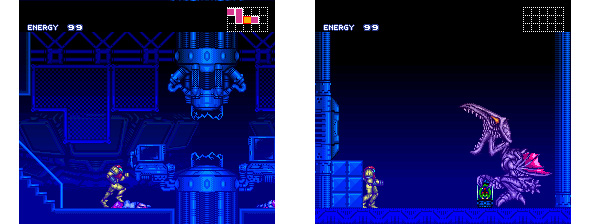Super Metroid – The Tenets of a Metroid Game
August 9th, 2010
The Tenets of a Metroid Game
Although Metroid can be categorized as a platforming shooter within a space-themed context, the franchise isn’t so much about the shooting or the jumping at all. Rather, Metroid is all about that misplaced bit of space rock. You know, the one with a little bit of extra fungus. The one that, after met with a morph ball bomb, will string you down a tiny alley to a small chamber containing the next power-up. Progression in Metroid hinges on the abilities granted by various power-ups which are connected to a string of environmental puzzles. It’s in the player’s ability to realize these puzzles through acute observation and then use their ability set to act upon their observations that Metroid reveals its true colors as a game of deep observation and multi-faceted problem solving. Metroid has always relished in being more than what it presents itself as, and series fans appreciate the franchise for valuing the deep implicit over the loud and overt. There’s a maturity in the series which has gone untarnished even as the franchise has evolved from two to three dimensions.
Metroid is also an innovator, but rarely proclaims its achievements on the back of the box. The Metroid games have not just defined but also realized a style of video game narrative that intertwines story with landscape. Oftentimes in a Metroid game, you’ll find yourself entering a world where events have long passed, and as the player you piece together story through the visual, audio and interactive pieces of the landscape (in the Metroid Prime sub-series text is also included). Through it’s environment Metroid builds a civilization and tasks the player as a defacto cultural architect. In this regard, many of the environmental puzzles, particularly those which require the use of machinery or are constituted with cultural relics, act as demonstrations of civil processes. Rarely do video games build lore this rich, or yet, so seamlessly into the fabric of the gameplay. Metroid is a narrative of few words, but with depth that many strive for.
Tense atmosphere and the sense of isolation felt by the player are also tenets of the Metroid franchise. In Super Metroid, the title screen with the baby metroid in the jar establishes an almost complete absence of life. Again, the setting, but, more correctly, the sound is used as a device to control mood. Where many other games opt for busy noise, Metroid instead opts for controlled instances of silence followed up crescendos which build and create tensions. Moments where little happens, but much is felt.
Since the atmosphere, narrative and overall framework for exploration are harmoniously built into the environment and therefore the gameplay, Metroid is a franchise that stands as a testament to good game design. As Metroid‘s design is very medium-centric, relying on the factors that define video games (interactivity, adaptive environments), the franchise excels at conveying atmosphere, narrative and challenge to the player.
More obvious to mainstream video games folk is the fact that Metroid, through protagonist Samus Aran, champions femininity without sexualization or even glorification of the empowerment of women. Metroid, particularly Super Metroid – the title in question – has been a standout title for speed running, the art of completing a game in the shortest time possible. Overall then, Metroid is an eminent video game series, a series which fosters exploration, harmonious narrative and gameplay, atmosphere, works against the grain of video game gender stereotypes, yet facilitates dedicated game communities through speed running. And for all this, in the sense of the games themselves, Metroid is modest about its achievements which makes it all the more a champion.






 Game Design Companion: A Critical Analysis of Wario Land 4 - $7.99
Game Design Companion: A Critical Analysis of Wario Land 4 - $7.99 Level Design: Processes and Experiences
Level Design: Processes and Experiences Speed Boost: The Hidden Secrets Behind Arcade Racing Design - $5.99
Speed Boost: The Hidden Secrets Behind Arcade Racing Design - $5.99 Adventures in Games Analysis: Volume I - $5.99
Adventures in Games Analysis: Volume I - $5.99







